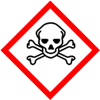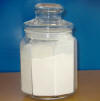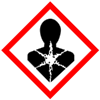Sodium Monochloroacetate Sodium Chloroacetate Manufacturers, SDS MSDS Sheet |
| Mubychem Limited of USA & India is a pioneer manufacturers suppliers exporters & importers of chemicals including Hydraulic fracturing stimulation & oil well production chemicals, Pharmaceutical excipients, Fragrance & flavor chemicals. Muby Chem Ltd has several manufacturing facilities and toll manufacturers across the globe. We have offices warehouses and representatives in Houston & Midland Texas and Chicago Illinois USA. |
| Our suppliers have accreditations like FDA - GMP-GLP approval, ISO-9001, ISO-22000 HACCP, Kosher & Halal Certification. We offer Commercial Pure Pharmacopoeia Analytical Reagent & Food Grade of Chemicals and do Toll Manufacturing for Oil well drilling fracking fracturing and others. |
Sodium Monochloroacetate Manufacturers; Sodium Chloroacetate Manufacturers
Sodium Chloroacetate SDS MSDS Sheet, Sodium Monochloroacetate Material Safety Data Sheet
Chloroacetic Acid Monosodium Salt
Chloroacetic Acid Sodium Salt
1. Product Identification
Synonyms: Sodium Chloroacetate; Monoxone; Sodium Monochloroacetate; Chloroacetic Acid, Sodium Salt.
CAS No.: 3926-62-3
Molecular Weight: 116.48
Chemical Formula: ClCH2COONa
2. Hazards Identification
GHS, Globally Harmonized System Classification in accordance with 29 CFR 1910
Classification according to Regulation (EC) No 1272/2008
Acute toxicity, Oral: Category 3
Acute toxicity, dermal Category 4
Skin corrosion/irritation Category 2
Serious eye damage/eye irritation Category 2A
Acute toxicity, Inhalation: Category 4
Acute aquatic toxicity: Category 3
Labeling according Regulation (EC) No 1272/2008
GHS Label Elements  Toxic |
GHS Label Elements |
GHS Label Elements |
Signal Words: Danger
Hazard Statements:
H301: Toxic if swallowed.
H312 Harmful in contact with skin.
H315 Causes skin irritation.
H319: Causes serious eye irritation.
H332: Harmful if inhaled.
H402: Harmful to aquatic life.
Precautionary Statements:
P301+P310: IF SWALLOWED: Immediately call a POSION CENTER or doctor/physician.
P273: Avoid release to the environment.
P260: Do not breathe dust/fume/gas/mist/vapors/spray.
P262: Do not get in eyes, on skin, or on clothing.
P271: Use only outdoors or in a well-ventilated area.
P264: Wash contaminated parts thoroughly after handling.
P270: Do not eat, drink or smoke when using this product.
P271: Use only outdoors or in a well-ventilated area.
P:273: Avoid release to the environment.
P280: Wear protective gloves/protective clothing/eye protection/face protection.
P312: Call a POISON CENTER or doctor/physician if you feel unwell.
P314: Get medical advice/attention if you feel unwell.
P302+352: IF ON SKIN: Wash with plenty of soap and water.
P304+P340: IF INHALED: Remove victim to fresh air and keep at rest in a position comfortable for breathing.
P305+351+338: IF IN EYES: Rinse cautiously with water for several minutes. P337+P313: If eye irritation persists get medical advice/attention.
Remove contact lenses if present and easy to do – continue rinsing.
P330: Rinse mouth.
P360: Rinse immediately contaminated clothing and skin with plenty of water before removing clothes.
P403+P404: Store in well-ventilated place. Keep container tightly closed.
P405: Store locked up.
P501: Dispose of contents/container in accordance with local/national regulation.
3. Composition/Information on Ingredients
Ingredient: Sodium chloroacetate or Sodium Monochloroacetate
CAS No.: 3926-62-3
4. First Aid Measures
Inhalation: Remove to fresh air. If not breathing, give artificial respiration. If breathing is difficult, give oxygen. Get medical attention.
Ingestion: Induce vomiting immediately as directed by medical personnel. Never give anything by mouth to an unconscious person. Get medical attention.
Skin Contact: Immediately flush skin with plenty of water for at least 15 minutes. Remove contaminated clothing and shoes. Get medical attention. Wash clothing before reuse. Thoroughly clean shoes before reuse.
Eye Contact: Check for and remove any contact lenses. Immediately flush eyes with running water for at least 15 minutes, keeping eyelids open. Cold water may be used. Do not use an eye ointment. Seek medical attention.
5. Fire Fighting Measures
Fire: Sodium Monochloroacetate or Sodium Chloroacetate is not expected to be a fire hazard.
Explosion: No information found.
Fire Extinguishing Media: Water spray, dry chemical, alcohol foam, or carbon dioxide.
Special Information: In the event of a fire, wear full protective clothing and NIOSH-approved self-contained breathing apparatus with full face piece operated in the pressure demand or other positive pressure mode.
6. Accidental Release Measures
Small Spill: Use appropriate tools to put the spilled solid in a convenient waste disposal container.
Large Spill: Use a shovel to put the material into a convenient waste disposal container.
7. Handling and Storage
Keep in a tightly closed container, stored in a cool, dry, ventilated area. Protect against physical damage. Isolate from incompatible substances. Containers of Sodium Monochloroacetate or Sodium Chloroacetate may be hazardous when empty since they retain product residues (dust, solids); observe all warnings and precautions listed for the product.
8. Exposure Controls/Personal Protection
Airborne Exposure Limits: None established.
Ventilation System: A system of local and/or general exhaust is recommended to keep employee exposures as low as possible. Local exhaust ventilation is generally preferred because it can control the emissions of the contaminant at its source, preventing dispersion of it into the general work area. Please refer to the ACGIH document, Industrial Ventilation, A Manual of Recommended Practices, most recent edition, for details.
Personal Respirators (NIOSH Approved): For conditions of use where exposure to dust or mist is apparent and engineering controls are not feasible, a particulate respirator (NIOSH type N95 or better filters) may be worn. If oil particles (e.g. lubricants, cutting fluids, glycerin, etc.) are present, use a NIOSH type R or P filter. For emergencies or instances where the exposure levels are not known, use a full-face positive-pressure, air-supplied respirator. WARNING: Air-purifying respirators do not protect workers in oxygen-deficient atmospheres.
Skin Protection: Wear protective gloves and clean body-covering clothing.
Eye Protection: Use chemical safety goggles and/or full face shield where dusting or splashing of solutions is possible. Maintain eye wash fountain and quick-drench facilities in work area.
9. Physical and Chemical Properties
Appearance: Sodium Monochloroacetate or Sodium Chloroacetate is white powder.
Odor: Odorless.
Solubility: Appreciable (> 10%)
Specific Gravity: No information found.
pH: 5.5
% Volatile by volume @ 21C (70F): 0
Boiling Point: No information found.
Melting Point: 170C (338F)
10. Stability and Reactivity
Stability: Stable under ordinary conditions of use and storage.
Hazardous Decomposition Products: May emit hydrogen chloride, chlorine, and oxides of sodium and carbon when heated to decomposition.
Hazardous Polymerization: Will not occur.
Incompatibilities: Strong acids.
Conditions to Avoid: Incompatibles.
11. Toxicological Information
Sodium Chloroacetate: Oral rat LD50: 95 mg/kg.
Carcinogenicity: This product is not classifiable as to its carcinogenicity based on its IARC, ACGIH, NTP, or EPA classification.
12. Ecological Information
Toxicity to fish: Rainbow trout LC50: 900.00 mg/l - 48.00 hrs.
Environmental Fate: No information found.
Environmental Toxicity: No information found.
13. Disposal Considerations
Whatever cannot be saved for recovery or recycling should be managed in an appropriate and approved waste disposal facility. Processing, use or contamination of this product may change the waste management options. State and local disposal regulations may differ from federal disposal regulations. Dispose of Sodium Monochloroacetate or Sodium Chloroacetate container and unused contents in accordance with law.
14. Transport Information
Domestic (Land, D.O.T.)
Proper Shipping Name: SODIUM CHLOROACETATE
Hazard Class: 6.1
UN/NA: UN2659
Packing Group: III
International (Water, I.M.O.)
Proper Shipping Name: SODIUM CHLOROACETATE
Hazard Class: 6.1
UN/NA: UN2659
Packing Group: III
International (Air, I.C.A.O.)
Proper Shipping Name: SODIUM CHLOROACETATE
Hazard Class: 6.1
UN/NA: UN2659
Packing Group: III
15. Regulatory Information
USA Regulations:
OSHA: Hazardous by definition of Hazard Communication Standard (29 CFR 1910.1200).
SARA 311/312: Acute: Yes; Chronic: No; Fire: No; Pressure: No; Reactivity: No (Pure / Solid)
SARA 313: Not applicable
SARA 313: Not applicable
SARA 313: Not applicable
WHMIS (Canada):
CLASS D-1B: Material causing immediate and serious toxic effects (TOXIC). CLASS D-2B: Material causing other toxic effects (TOXIC).
16. Other Information
Disclaimer:
*********************************
Our company provides this Sodium Chloroacetate or Sodium Monochloroacetate SDS information sheet contained herein in good faith but makes no representation as to its
comprehensiveness or accuracy. This Sodium Chloroacetate MSDS sheet is intended only as a guide to the appropriate precautionary handling of the material by a properly
trained person using this product. Individuals receiving the information must exercise their independent judgment in determining its appropriateness for a particular
purpose.
*********************************
Suppliers Manufacturers Exporters Importers between USA Canada UAE Europe South Africa Tanzania Kenya Uganda Egypt Nigeria Turkey Mexico Brazil Argentina Chile Dubai China India etc.
Copyright and Usual Disclaimer is Applicable.
If you feed a dog with your hand, it will never bite you. That is the principal difference between a dog and a man.









